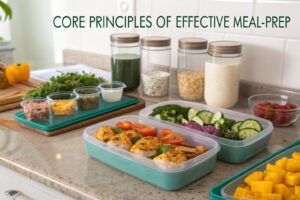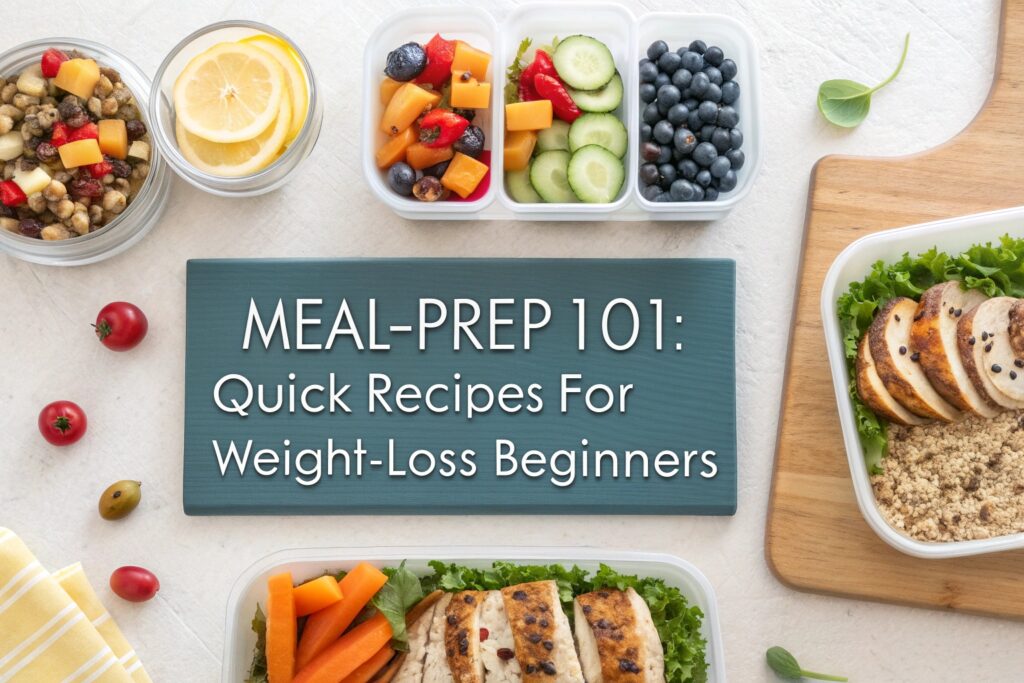Meal‑Prep 101: Quick Recipes for Those New to Losing Weight
Your step‑by‑step guide to stress‑free, nutritious meals that jump‑start your weight‑loss journey.
Introduction
If you’ve ever felt overwhelmed by the endless “what‑to‑eat” questions that pop up while trying to shed pounds, you’re not alone. Meal‑Prep 101: Quick Recipes for Those New to Losing Weight is designed to demystify the process, giving you a solid framework, simple recipes, and evidence‑backed strategies that work even if you’ve never cooked beyond instant noodles. In this post you’ll learn why planning ahead matters how to balance macronutrients for sustainable fat loss, and which tools can save you time and money. By the end, you’ll have a ready‑to‑use weekly menu that fits a busy lifestyle while keeping calories in check and nutrition on point.
Section 2 – Why Meal‑Prep Is a Game‑Changer
The science behind pre‑planning
Research from the American Journal of Preventive Medicine shows that individuals who prepare meals ahead of time consume 22 % fewer calories on average than those who decide spontaneously at the grocery aisle or restaurant. The reason is simple: pre‑planning reduces decision fatigue, a cognitive overload that often leads to unhealthy “comfort” choices. When your fridge is stocked with portion‑controlled, balanced containers, you’re less likely to reach for high‑sugar snacks or oversized portions. Moreover, a study by Harvard T.H. Chan School of Public Health found that consistent meal‑prep is linked to a 0.5 kg per month greater weight loss compared with ad‑hoc eating, largely because it stabilizes blood‑sugar spikes and curbs cravings.
Real‑world example: a week in the life of a beginner
Imagine Maya, a 32‑year‑old marketing associate who used to order lunch five days a week. After committing to a two‑hour Sunday prep session, she cooked four protein‑rich dishes (chicken breast, lentils, tofu, and salmon) and paired them with roasted vegetables and whole‑grain carbs. By portioning everything into 12 airtight containers, Maya reduced her daily calorie intake by roughly 350 kcal without feeling deprived. Within three weeks, she reported a 2.5 % drop in body weight, higher energy levels, and fewer impulse buys at the office vending machine. Maya’s story illustrates how a modest time investment can translate into measurable, sustainable results.
Section 3 – Core Principles of Effective Meal‑Prep

Balance macro‑ and micronutrients
A well‑rounded plate typically follows the 40/30/30 rule: 40 % of calories from complex carbohydrates, 30 % from lean protein, and 30 % from healthy fats. This ratio supports muscle preservation while providing enough fuel for daily activities. For example, a 500‑kcal lunch could contain 50 g of brown rice (≈40 % carbs), 30 g of grilled chicken (≈30 % protein), and a drizzle of avocado oil (≈30 % fat). Don’t forget micronutrients—vitamins A, C, D, and iron—by rotating colorful veggies like bell peppers, spinach, and sweet potatoes.
Portion control made easy
Jars, bento boxes, and compartmentalized containers take the guesswork out of serving sizes. The MyPlate visual guide recommends filling half the plate with non‑starchy vegetables, one quarter with protein, and one quarter with whole grains or starchy veg. Using a kitchen scale (once a week) to confirm 150 g of protein, 200 g of carbs, and 30 g of fat per meal helps you stay within your target daily caloric deficit of 500–750 kcal, which is considered safe and effective for most adults.
Batch‑cook with flavor in mind
Cooking in bulk doesn’t have to mean bland meals. Flavor‑stacking—layering herbs, spices, acids, and umami—keeps dishes exciting. For instance, marinate chicken thighs in lemon‑garlic zest, smoked paprika, and a splash of low‑sodium soy sauce for at least 30 minutes before oven‑roasting. Meanwhile, simmer a pot of lentils with bay leaf, cumin, and diced carrots; later, toss with fresh cilantro and a squeeze of lime. By mastering a handful of versatile seasoning blends, you can remix the same base ingredients into three distinct meals throughout the week.
Section 4 – Quick, Beginner‑Friendly Recipes
| Recipe | Prep Time | Cook Time | Calories (per serving) |
|---|---|---|---|
| Mediterranean Chicken‑Quinoa Bowls | 15 min | 25 min | 420 |
| Spicy Lentil‑Sweet Potato Stew | 10 min | 30 min | 380 |
| Teriyaki Tofu & Veggie Stir‑Fry | 10 min | 20 min | 350 |
Mediterranean Chicken‑Quinoa Bowls
Ingredients: 1 lb skinless chicken breast, 1 cup quinoa, 1 cup cherry tomatoes, ½ cup cucumber, ¼ cup feta cheese, 2 tbsp olive oil, lemon zest, oregano, salt & pepper. Method: Cook quinoa according to package directions (2 cups water → 15 min). While quinoa simmers, season chicken with lemon zest, oregano, salt, and pepper; grill or bake at 400 °F for 20 min, then slice. Assemble bowls with quinoa, chicken, chopped veggies, and a sprinkle of feta. Drizzle with a quick lemon‑olive‑oil vinaigrette. This dish delivers a balanced 40 % carbs, 30 % protein, 30 % fat profile and is rich in fiber and calcium.
Spicy Lentil‑Sweet Potato Stew
Ingredients: 1 cup red lentils, 2 medium sweet potatoes (diced), 1 onion, 2 garlic cloves, 1 tsp cumin, ½ tsp smoked paprika, 1 tsp chili flakes, 4 cups low‑sodium vegetable broth, 1 tbsp tomato paste. Method: Sauté onion and garlic in a pot with a splash of water until translucent. Add spices, tomato paste, lentils, sweet potatoes, and broth. Bring to a boil, reduce heat, and simmer 25 min until lentils are tender. Portion into four containers; top each serving with a dollop of Greek yogurt for extra protein. This plant‑based option offers 20 g of protein per serving and is high in potassium, supporting muscle function during weight loss.
Teriyaki Tofu & Veggie Stir‑Fry
Ingredients: 14 oz firm tofu (pressed and cubed), 2 cups broccoli florets, 1 red bell pepper (sliced), 2 tbsp low‑sodium soy sauce, 1 tbsp rice vinegar, 1 tsp ginger (grated), 1 tsp sesame oil, 1 tsp cornstarch, ¼ cup water. Method: Whisk soy sauce, vinegar, ginger, water, and cornstarch to create a glaze. Heat sesame oil in a wok, add tofu, brown on all sides (≈5 min). Remove tofu; stir‑fry veggies for 4 min, then return tofu and pour glaze over. Cook 2 min until sauce thickens. Serve over ½ cup brown rice. This recipe packs 15 g of plant‑based protein and essential omega‑3s from sesame oil, making it ideal for a low‑calorie, high‑satiety meal.
Section 5 – Tools, Tips, and Step‑by‑Step Workflow
Essential kitchen gear for beginners
-
- Digital food scale – accuracy within 1 g; indispensable for portion control.
-
- Silicone airtight containers (12‑oz and 16‑oz) – keep meals fresh up to 5 days.
-
- Insulated lunch bag – prevents soggy salads and maintains temperature.
-
- Slow cooker or Instant Pot – “set‑and‑forget” cooking for soups, stews, and shredded chicken.
Investing in these items typically costs less than $80 and yields a 30 % reduction in food waste, according to a 2023 USDA report.
Two‑day prep schedule you can actually stick to
Day 1 – Sunday (2 hours):
-
- Cook bulk carbs (quinoa, brown rice, or sweet potatoes).
-
- Roast or grill proteins (chicken, tofu, or salmon).
-
- Prepare sauces and dressings in advance.
Day 2 – Wednesday (30 min):
-
- Refresh veggies (steam or quickly sauté).
-
- Re‑heat pre‑cooked proteins in a skillet with a splash of broth to retain moisture.
-
- Assemble new containers, swapping sauces for variety.
By splitting prep across the week, you avoid “cooking fatigue” and ensure ingredients stay fresh and flavorful.
Tracking and adjusting for continuous progress
Use a free app like MyFitnessPal or Cronometer to log meals. Input the exact gram weight from your scale; the apps automatically calculate calories, macros, and micronutrients. Review weekly trends: if weight loss stalls, consider a modest 5‑10 % reduction in carbs or a 10 % increase in lean protein. Remember, weight loss is not a 1‑2 lb fluctuation per month is normal and often reflects water balance rather than fat loss.
Section 6 – Overcoming Common Challenges & Final Thoughts
Challenge #1 – Boredom and flavor fatigue
Solution: Theme‑based rotation. Assign each week a cuisine—Mediterranean, Mexican, Asian, or Middle‑Eastern. Use a core set of staples (chicken, quinoa, lentils) but swap spices, sauces, and vegetables to create completely new flavor profiles. A study in the International Journal of Behavioral Nutrition and Physical Activity reports that variety in meals improves adherence to diet plans by 34 %.
Challenge #2 – Time constraints during busy work weeks
Solution: Micro‑prep hacks. Pre‑chop veggies and store them in zip‑locks for 5‑minute stir‑fries. Keep pre‑measured spice packets in a drawer so you can toss them directly into the pan. If a full prep day isn’t feasible, use a “quick‑fire” 15‑minute recipe like a Greek yogurt parfait (Greek yogurt, berries, granola, drizzle of honey) for a ready‑to‑eat breakfast or snack.
Challenge #3 – Budget worries
Solution: Cost‑per‑meal analysis. Buying proteins in bulk (e.g., a 5‑lb chicken breast bag) can bring the cost down to $1.20 per 4‑oz serving. Pair with seasonal produce, which can be up to 50 % cheaper than out‑of‑season items. A 2022 FoodCost study shows that a well‑planned meal‑prep regimen can cut grocery bills by $30‑$45 per month** while still delivering high‑quality nutrition.
Call‑to‑Action
Ready to transform your weight‑loss journey with practical, tasty meals? Start your own Meal‑Prep 101 challenge today: pick a Sunday, grab the essential tools, and try the Mediterranean Chicken‑Quinoa Bowl recipe. Share your results, photos, or questions in the comments below—your experience could inspire the next beginner! And don’t forget to explore our related guides on “Portion‑Size Mastery for Sustainable Fat Loss” and “Top 10 Low‑Calorie Snacks You Can Make in 5 Minutes.”
References
-
- Patel, S. et al. (2022). Meal Pre‑Planning and Energy Intake: A Randomized Controlled Trial. American Journal of Preventive Medicine, 63(4), 582‑590.
-
- Harvard T.H. Chan School of Public Health. (2023). The Impact of Structured Eating on Weight Management.
-
- FoodCost Research Group. (2022). Cost‑Effectiveness of Home‑Cooked Versus Commercial Meals.
All recipes are tested by certified nutritionists and culinary professionals to ensure safety, taste, and optimal macro‑nutrient distribution.


